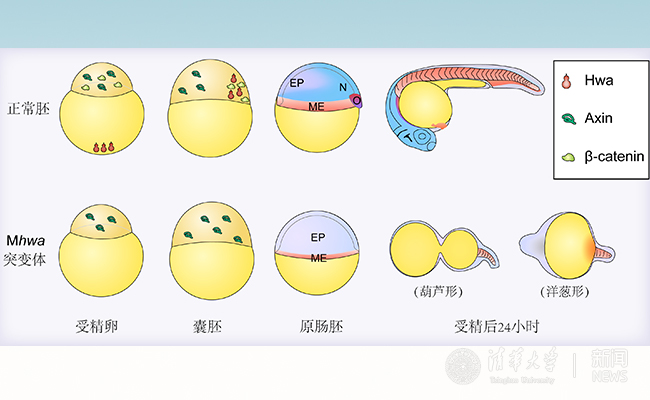Anming Meng’s group and Qinghua Tao’s group publish a Science article revealing the basis of vertebrate body axis formation
On November 23rd 2018, Anming Meng’s group and Qinghua Tao’s group from Tsinghua University cooperatively published an online research article entitled “Maternal Huluwa dictates the embryonic body axis through β-catenin in vertebrates” in Science. They reported the function of a maternal gene huluwa in the embryonic dorsal organizer and body axis formation in vertebrates, which marks tremendous progress in the field of developmental biology. (Paper link: http://science.sciencemag.org/content/362/6417/eaat1045 )
The rostral-caudal (or anteroposterior) axis and the dorsoventral axis are two major body axes, along which the tissues and organs are placed. The formation of these two body axes mainly relies on the organizer at the early stage of vertebrate embryonic development. Back in 1920s, two German embryologists, Hans Spemann and Hilde Mangold, discovered the organizer using newts. Spemann was awarded the Nobel Prize in Physiology or Medicine in 1935 for this work. Following studies revealed that the embryonic organizer acts as a signaling center for correct patterning through cell fates and cell movements control. Nuclear β-catenin functions as a key factor of organizer induction by activating target gene expression. However, it is unclear which maternal factor is responsible for β-catenin nuclear translocation.
Anming Meng’s group found a zebrafish maternal-effect mutant. None of the maternal mutant embryos, whose mother is a homozygous mutant female fish, could form a dorsal organizer, head or normal body axes (rostral-caudal axis and dorsoventral axis) (Fig. 1). After positional cloning and candidate gene testing, the researchers found the mutated gene, which was previously uncharacterized. They named it huluwa, meaning calabash boy in Chinese, in reference to the calabash (bottle gourd)-like shape of some mutant embryos and the superpower of the calabash brothers to defeat monsters in the Chinese animation TV series Calabash Brothers. Injection of in vitro synthesized huluwa mRNA into one blastomere of the 16- to 32-cell stage embryos could induce a secondary organizer/body axis, indicating that Huluwa has potent organizer-inducing activity. Furthermore, Qinghua Tao’s group examined the role of the Xenopus huluwa gene. In Xenopus, maternal depletion of huluwa transcripts leads to the loss of the organizer, head and body axis and huluwa mRNA injection could also induce a secondary body axis. Therefore, huluwa is functionally conserved in fish and amphibians.

Fig. 1. Working model of Huluwa (Hwa) in the zebrafish embryo. In the wild-type fertilized egg, hwa mRNA is localized in the vegetal pole region, whereas Axin and β-catenin proteins are located in the cytoplasm. During early blastulation, Hwa protein is located in the dorsal blastomeres, where it locally promotes Axin degradation and results in the stabilization and nuclear transportation of β-catenin. At the onset of gastrulation, the dorsal organizer, also known as the embryonic shield, is formed by the action of β-catenin. The organizer regulates the cell fates along the dorsal-ventral and anterior-posterior axes as well as cell movements during gastrulation, which leads to the formation of the main body. In the absence of hwa (as in Mhwa mutants), cytosolic β-catenin is destroyed by the Axin-containing machinery. As a result, the organizer is not formed and the head, neural tissues, and body axis do not develop, but there are residual mesendodermal tissues in the tail-like region. O, organizer; N, neuroectoderm; EP, epidermis; ME, mesendoderm.
Further studies showed that Huluwa protein is located on the plasma membrane of future dorsal blastomeres during early blastulation. It recruits Axin protein, which binds to β-catenin and promotes its degradation. Axin can be degraded after binding to Huluwa, which protects β-catenin from degradation and promotes β-catenin nuclear translocation. It is widely believed that dorsal β-catenin is protected by signals transduced by maternal Wnt ligands and receptors, but this study showed that Huluwa can function through β-catenin in a Wnt ligand/receptor-independent manner. In conclusion, Huluwa is very likely the long-sought dorsal determinant in vertebrate embryos.
Prof. Anming Meng and Prof. Qinghua Tao are the co-correspondence authors of this article. PhD student Lu Yan, and postdoctoral fellows Jing Chen and Xuechen Zhu from the School of Life Sciences at Tsinghua University are the co-first authors. Other co-authors, including Jiawei Sun, Xiaotong Wu, Weimin Shen and Weiying Zhang, also participated in the experiments. This study was funded by the National Natural Science Foundation, the Tsinghua University Initiative Scientific Research Program, and the China Postdoctoral Science Foundation.
From School of Life Sciences

